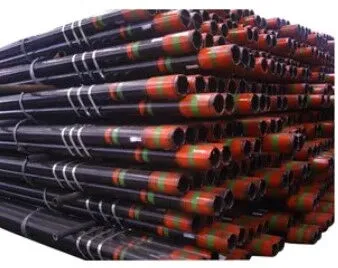Oil casing is a crucial piece of equipment in the oil drilling process. It plays a key role in ensuring the stability of the wellbore structure and the safety of the operation. As a protective barrier, oil casing not only prevents the wellbore walls from collapsing but also isolates different geological layers. This prevents the cross-contamination of fluids. Proper installation and use of oil casing directly affect the safety, efficiency, and environmental impact of drilling operations. Therefore, it is important for oil and gas industry professionals to understand the functions, types, materials, and installation methods of oil casing.
The primary function of oil casing is to ensure the stability of the wellbore and the integrity of the well walls. During drilling, the drill bit passes through different underground geological layers. These layers may contain high pressure, toxic gases, or other hazardous materials. The installation of casing prevents these substances from entering the wellbore, protecting the safety of workers. Additionally, oil casing helps prevent the wellbore from collapsing. It keeps the well stable and stops loose materials from entering the well, ensuring smooth oil and gas extraction.
Oil casing also isolates different layers and the wellbore. This prevents the migration of fluids between layers. For example, oil casing can separate aquifers from oil and gas layers. It prevents contamination of groundwater and protects water resources. The sealing performance of the casing is essential for oil and gas extraction. It prevents blowouts, leaks, and other safety issues, ensuring safe and smooth operations.

There are different types of oil casing, each designed for specific functions and uses. The following types are commonly used based on operational needs.
This is the first casing installed during drilling. It is placed in the uppermost geological layers. Its main function is to protect groundwater and the environment. It prevents drilling fluids from contaminating the groundwater and provides a stable foundation for the installation of other casings.
Intermediate casing isolates unstable geological layers. It prevents the wellbore from collapsing and formation slippage. This casing is installed after the surface casing. It protects deeper geological structures and prevents the leakage of high-pressure gases or toxic substances.
Production casing is installed near the reservoir. It acts as a pipeline for transporting oil and gas from the underground reservoir to the surface. The sealing and strength of this casing directly affect the efficiency and safety of oil and gas extraction.
Liner casing is shorter than other types. It extends the casing string but does not connect to the surface. It is often used in deep well operations to ensure the smooth completion of drilling.
Oil casing must withstand high temperatures, high pressures, and corrosive environments during drilling. Therefore, the choice of casing material is critical. Common materials used for oil casing include:
Carbon Steel: Carbon steel is widely used because of its strength and durability. It is suitable for most standard drilling environments. It can withstand general pressure and temperature conditions and is relatively cost-effective.
Alloy Steel: Alloy steel casing offers greater corrosion resistance and better high-temperature performance. It is often used in corrosive environments, such as offshore drilling or deep well operations.
Stainless Steel: Stainless steel casing resists high temperatures, high pressures, and corrosion. It is suitable for high-temperature, high-pressure wells (HTHP) and extreme environments. It effectively prevents corrosion and damage from harsh conditions.
The installation of oil casing is a precise process that must follow design specifications. During installation, the casing is lowered into the wellbore in sections, and cement is used to secure it in place. This ensures a seal between the casing and the wellbore. The seal prevents fluid migration between geological layers and helps prevent oil and gas leaks or blowouts, ensuring safety during drilling.
The quality of cementing is directly linked to the safety and productivity of the oil well. Proper cementing ensures that the casing is securely attached to the wellbore and can withstand high temperatures and pressures. Cementing also prevents contamination of groundwater and harmful substances, protecting the environment.
In addition to ensuring the safety of drilling operations, oil casing plays an important role in environmental protection. The casing prevents pollutants from entering groundwater. It also stops drilling fluids or oil and gas from leaking into the environment, safeguarding water resources. By preventing contamination of geological layers and the wellbore, oil casing provides stable conditions for oil and gas extraction.
Oil casing is an essential and critical piece of equipment in oil drilling operations. It plays a vital role in maintaining the stability of the wellbore, ensuring safety during operations, and protecting the environment. By selecting the appropriate casing type, material, and installation method, drilling efficiency and safety can be improved. The quality and performance of oil casing directly impact the success of drilling operations. Therefore, the proper selection, installation, and maintenance of casing are crucial for ensuring the smooth extraction of oil and gas. Oil companies, drilling contractors, and equipment suppliers must prioritize the quality of oil casing and construction techniques to ensure the successful extraction of every oil well.
